#fu Ching Chen
Text
FISTS OF FURY:
A student returns
To avenge his master’s death
Fights for his people
youtube
#fists of fury#random richards#poem#haiku#poetry#haiku poem#haiku poetry#haiku form#poetic#criterion collection#bruce lee#jing wu men#the chinese medicine#Nora Miao#James tien#Maria yi#Wei lo#fu Ching Chen#Youtube
0 notes
Text
The Post-Truth World

Movies watched in 2023
The Post-Truth World (2022, Taiwan)
Director: Chen I-Fu
Writer: Nai-Ching Yeh
Mini-review:
The Post-Truth World is a well acted, solid thriller. It's not brilliant by any means, but it's entertaining enough and it makes some great point about how far the media is willing to go in order to get views. That being said, I didn't like the final part, cause I think it took the easy way out and the ending turned out rather underwhelming. The cast is great, though, and it carries the movie through its weakest points.
#the post truth world#the post-truth world#chen i-fu#nai-ching yeh#joseph chang#edward chen#chen hao-sen#chen hao sen#chang hsiao chuan#chang hsiao-chuan#caitlin fang#aviis zhong#amber an#thriller#movies watched in 2023
3 notes
·
View notes
Text
Getting Revenge on EVIL is a 6-Year Plan! "Kill Butterfly Kill" reviewed! (Neon Eagle Video / Blu-ray)
“Kill Butterfly Kill” – Both Films Available on Blu-ray!
Caught on the wrong side of the tracks during a torrential downpour one dark and stormy night, a soaked Mei-Ling seeks shelter in a haybarn where a group of drunk men are playing cards. Through an intoxicated lens of brash confidence, the men rape Mei-Ling as if the whole ordeal was nothing more than a game, like them playing cards. For…

View On WordPress
#1982#4K#blu-ray#Bruce Li#Charles Lee#Chen-Peng Kao#Ching-Kang Yao#Commando Fury#Fei Lung#Fortuna Film Company#Fu-Cheng Chen#Godfrey Ho#Hei Shi Fu Ren#Hung-Lieh Chen#IFD#International Film Distributors#Kenneth Brorsson#Kill Butterfly Kill#King of Snakes#Kuan-Wu Lung Ta-Chuan Chang#Li Hsu#Li-Yun Chen#Mark Miller#martial arts#Mike Abbott#MVD#MVDVisual#Neon Eagle Video#nudity#One-Armed Swordsman Vs Nine killers
0 notes
Text
[mdzs] In depth analysis of Lan Xichen’s name
It’s been 2.5 years since my last MDZS name analysis(!!), and since then I’ve gotten so many requests from the fandom wanting to see more. So here’s to everyone who have enjoyed reading my posts so far - today I’ll be diving into Lan Xichen’s name. Sit back as this is an interesting one!

Lan Xichen is his zi ,or courtesy name, which means ‘chancellor of the morning sunlight’ (Xi 曦 - morning sunlight; Chen 臣- chancellor, minister).
It derives from the poem ‘Xian Qing Fu’ 《闲情赋》 (Ode to a Quiet Life) by Eastern Jin dynasty recluse poet Tao Yuan Ming 陶渊明. Tao is remembered for his appreciation of beauty and serenity of the natural world around him, often admiring the good of others and documenting his wishes for a peaceful and fair society. (NB: The majority of Chinese people would know of the phrase ‘世外桃源’ - Xanadu / fantastical place of great idyllic magnificence and beauty, which originated from him.) This particular poem is a long study on the beauty and virtues of an idealised woman, and is known today as one of the most iconic bodies of work celebrating a woman’s true inner qualities. “悲晨曦之易夕,感人生之长勤” (bēi chén xī zhī yì xī, gǎn rén shēng zhī cháng qín), translates figuratively to ‘it is regrettable that the light of this morning will soon be replaced by the dark night, reminding people that life is filled with endless fatigue.’
One can’t help but draw parallels to Xichen’s life - he was always a noble figure, approached people with sincerity, treated everyone with an equal level of respect and believed deeply in those he stayed close to. But life could not always pay back what he gave to others, as he learnt of his trusted friend Jin Guangyao’s corrupt ways and betrayal - the light that was replaced by darkness.
I find it fascinating how poet Tao’s perspective of the world is so similar to Xichen’s. Tao is known for spending much of his life in reclusion, living in the countryside, receiving only a few guests he had a strong bond with, reading and indulging in his love for poetry. As a talented and knowledgeable man, he spent a decade of his life as a politician - but soon lost faith in a system that was characterised by nepotism, violence, corruption and civil disorder. Torn between ambition and the desire to retreat into solitude, he chose the latter. I wonder if MXTX drew inspiration from this, as Xichen also began as a leader in the cultivators’ world, is a huge lover and collector of literature, and after all the turmoil also decided to withdraw into reclusion.
Xichen’s birth name is 涣 (Huàn), which has two main meanings: 1) ‘melting of snow’; 2) ‘water dispersing in all directions’. His title is 泽芜君 (zé wú jūn), which literally means ‘nourisher of barren lands’ (泽润 - to nourish, bestow; 平芜 - land overgrown with weeds). Combining the two, we can understand his name to mean ‘water disperses in all directions, nourishing everything it touches’. 泽 in Chinese is used specifically to describe bestowing something deep, long-lasting and meaningful (as supposed a one time gift/favour - which would be 惠). In the book, MXTX also describes him as “清煦温雅,款款温柔” (meaning ‘warm, gracious and elegant, gentle in all aspects’). Clearly, his name highlights the grace and kindness he radiates and bestows on everyone around him. He is the keeper of peace and righteousness.
Bonus:
Note that the word Huan 涣 has a water particle, similar to his brother Lan Wangji’s birth name Zhan 湛 - it brings to mind the ‘Twin Jades of Lan’ title for the brothers, with a water element - like Pisces.
Interestingly, in ‘I Ching’ or ‘Book of Changes’, the ancient Chinese divination text which contains of 64 hexagrams, there is a 涣 hexagram:

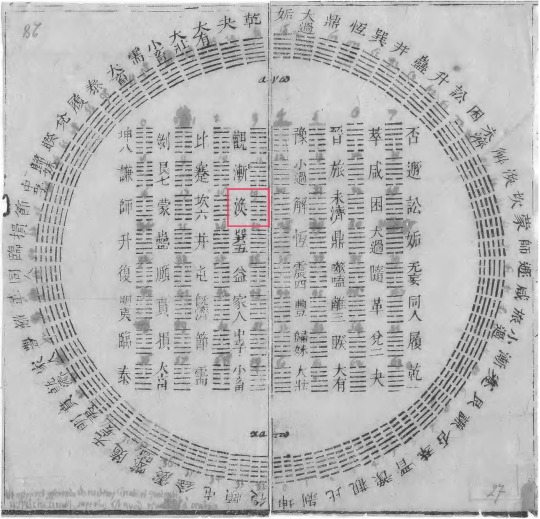
Again, it represents how gentleness can summon greatness. I copy the below from iching-online.com:

In simple terms, it symbolises water that washes away dirt and baptises new life within oneself. And the aftermath is precisely Zhan 湛 in his brother’s name, meaning crystal clear water.
Other name analyses:
Wei Wuxian
Lan Wangji
Jiang Wanyin
Lan Sizhui
#the untamed#mo dao zu shi#mdzs#mdzs meta#lan xichen#Chinese names#name analysis#male names#蓝曦臣#lan huan#蓝涣#魔道祖师#蓝湛#lan zhan#i ching#64 hexagrams#Chinese novel#Chinese drama#Chinese#Chinese cultural#陈情令#chen qing ling#cql
535 notes
·
View notes
Text
List of Gods, most of which are no longer worshipped. via /r/atheism
List of Gods, most of which are no longer worshipped.
Middle-East
A, Adad, Adapa, Adrammelech, Aeon, Agasaya, Aglibol, Ahriman, Ahura Mazda, Ahurani, Ai-ada, Al-Lat, Aja, Aka, Alalu, Al-Lat, Amm, Al-Uzza (El-'Ozza or Han-Uzzai), An, Anahita, Anath (Anat), Anatu, Anbay, Anshar, Anu, Anunitu, An-Zu, Apsu, Aqhat, Ararat, Arinna, Asherali, Ashnan, Ashtoreth, Ashur, Astarte, Atar, Athirat, Athtart, Attis, Aya, Baal (Bel), Baalat (Ba'Alat), Baau, Basamum, Beelsamin, Belit-Seri, Beruth, Borak, Broxa, Caelestis, Cassios, Lebanon, Antilebanon, and Brathy, Chaos, Chemosh, Cotys, Cybele, Daena, Daevas, Dagon, Damkina, Dazimus, Derketo, Dhat-Badan, Dilmun, Dumuzi (Du'uzu), Duttur, Ea, El, Endukugga, Enki, Enlil, Ennugi, Eriskegal, Ereshkigal (Allatu), Eshara, Eshmun, Firanak, Fravashi, Gatamdug, Genea, Genos, Gestinanna, Gula, Hadad, Hannahanna, Hatti, Hea, Hiribi, The Houri, Humban, Innana, Ishkur, Ishtar, Ithm, Jamshid or Jamshyd, Jehovah, Jesus, Kabta, Kadi, Kamrusepas, Ki (Kiki), Kingu, Kolpia, Kothar-u-Khasis, Lahar, Marduk, Mari, Meni, Merodach, Misor, Moloch, Mot, Mushdama, Mylitta, Naamah, Nabu (Nebo), Nairyosangha, Nammu, Namtaru, Nanna, Nebo, Nergal, Nidaba, Ninhursag or Nintu, Ninlil, Ninsar, Nintur, Ninurta, Pa, Qadshu, Rapithwin, Resheph (Mikal or Mekal), Rimmon, Sadarnuna, Shahar, Shalim, Shamish, Shapshu, Sheger, Sin, Siris (Sirah), Taautos, Tammuz, Tanit, Taru, Tasimmet, Telipinu, Tiamat, Tishtrya, Tsehub, Utnapishtim, Utu, Wurusemu, Yam, Yarih (Yarikh), Yima, Zaba, Zababa, Zam, Zanahary (Zanaharibe), Zarpandit, Zarathustra, Zatavu, Zazavavindrano, Ziusudra, Zu (Imdugud), Zurvan
China:
Ba, Caishen, Chang Fei, Chang Hsien, Chang Pan, Ch'ang Tsai, Chao san-Niang, Chao T'eng-k'ang, Chen Kao, Ch'eng Huang, Cheng San-Kung, Cheng Yuan-ho, Chi Po, Chien-Ti, Chih Jih, Chih Nii, Chih Nu, Ch'ih Sung-tzu, Ching Ling Tzu, Ch'ing Lung, Chin-hua Niang-niang, Chio Yuan-Tzu, Chou Wang, Chu Niao, Chu Ying, Chuang-Mu, Chu-jung, Chun T'i, Ch'ung Ling-yu, Chung Liu, Chung-kuei, Chung-li Ch'üan, Di Jun, Fan K'uei, Fei Lien, Feng Pho-Pho, Fengbo, Fu Hsing, Fu-Hsi, Fu-Pao, Gaomei, Guan Di, Hao Ch'iu, Heng-o, Ho Po (Ping-I), Hou Chi, Hou T'u, Hsi Ling-su, Hsi Shih, Hsi Wang Mu, Hsiao Wu, Hsieh T'ien-chun, Hsien Nung, Hsi-shen, Hsu Ch'ang, Hsuan Wen-hua, Huang Ti, Huang T'ing, Huo Pu, Hu-Shen, Jen An, Jizo Bosatsu, Keng Yen-cheng, King Wan, Ko Hsien-Weng, Kuan Ti, Kuan Ti, Kuei-ku Tzu, Kuo Tzu-i, Lai Cho, Lao Lang, Lei Kung, Lei Tsu, Li Lao-chun, Li Tien, Liu Meng, Liu Pei, Lo Shen, Lo Yu, Lo-Tsu Ta-Hsien, Lu Hsing, Lung Yen, Lu-pan, Ma-Ku, Mang Chin-i, Mang Shen, Mao Meng, Men Shen, Miao Hu, Mi-lo Fo, Ming Shang, Nan-chi Hsien-weng, Niu Wang, Nu Wa, Nu-kua, Pa, Pa Cha, Pai Chung, Pai Liu-Fang, Pai Yu, P'an Niang, P'an-Chin-Lien, Pao Yuan-ch'uan, Phan Ku, P'i Chia-Ma, Pien Ho, San Kuan, Sao-ch'ing Niang, Sarudahiko, Shang Chien, Shang Ti, She chi, Shen Hsui-Chih, Shen Nung, Sheng Mu, Shih Liang, Shiu Fang, Shou-lao, Shun I Fu-jen, Sien-Tsang, Ssu-ma Hsiang-ju, Sun Pin, Sun Ssu-miao, Sung-Chiang, Tan Chu, T'ang Ming Huang, Tao Kung, T'ien Fei, Tien Hou, Tien Mu, Ti-tsang, Tsai Shen, Ts'an Nu, Ts'ang Chien, Tsao Chun, Tsao-Wang, T'shai-Shen, Tung Chun, T'ung Chung-chung, T'ung Lai-yu, Tung Lu, T'ung Ming, Tzu-ku Shen, Wa, Wang Ta-hsien, Wang-Mu-Niang-Niang, Weiwobo, Wen-ch'ang, Wu-tai Yuan-shuai, Xi Hou, Xi Wangmu, Xiu Wenyin, Yanwang, Yaoji, Yen-lo, Yen-Lo-Wang, Yi, Yu, Yu Ch'iang, Yu Huang, Yun-T'ung, Yu-Tzu, Zaoshen, Zhang Xi, , Zhinü, , Zhongguei, , Zigu Shen, , Zisun, Ch'ang-O
Slavic:
Aba-khatun, Aigiarm, Ajysyt, Alkonost, Almoshi, Altan-Telgey, Ama, Anapel, As-ava, Ausaitis, Austeja, Ayt'ar, Baba Yaga (Jezi Baba), Belobog (Belun), Boldogasszony, Breksta, Bugady Musun, Chernobog (Crnobog, Czarnobog, Czerneboch, Cernobog), Cinei-new, Colleda (Koliada), Cuvto-ava, Dali, Darzu-mate, Dazhbog, Debena, Devana, Diiwica (Dilwica), Doda (Dodola), Dolya, Dragoni, Dugnai, Dunne Enin, Edji, Elena, Erce, Etugen, Falvara, The Fates, The Fatit, Gabija, Ganiklis, Giltine, Hotogov Mailgan, Hov-ava, Iarila, Isten, Ja-neb'a, Jedza, Joda-mate, Kaldas, Kaltes, Keretkun, Khadau, Khursun (Khors), Kostrubonko, Kovas, Krumine, Kupala, Kupalo, Laima, Leshy, Marina, Marzana, Matergabiae, Mat Syra Zemlya, Medeine, Menu (Menulis), Mir-Susne-Khum, Myesyats, Nastasija, (Russia) Goddess of sleep., Nelaima, Norov, Numi-Tarem, Nyia, Ora, Ot, Patollo, Patrimpas, Pereplut, Perkuno, Perun, Pikuolis, Pilnytis, Piluitus, Potrimpo, Puskaitis, Rod, Rugevit, Rultennin, Rusalki, Sakhadai-Noin, Saule, Semargl, Stribog, Sudjaje, Svantovit (Svantevit, Svitovyd), Svarazic (Svarozic, Svarogich), Tengri, Tñairgin, Triglav, Ulgen (Ulgan, Ülgön), Veles (Volos), Vesna, Xatel-Ekwa, Xoli-Kaltes, Yamm, Yarilo, Yarovit, Ynakhsyt, Zaria, Zeme mate, Zemyna, Ziva (Siva), Zizilia, Zonget, Zorya, Zvoruna, Zvezda Dennitsa, Zywie
Hindu
Aditi, Adityas, Ambika, Ananta (Shesha), Annapurna (Annapatni), Aruna, Ashvins, Balarama, Bhairavi, Brahma, Buddha, Dakini, Devi, Dharma, Dhisana, Durga, Dyaus, Ganesa (Ganesha), Ganga (Ganges), Garuda, Gauri, Gopis, Hanuman, Hari-Hara, Hulka Devi, Jagganath, Jyeshtha, Kama, Karttikeya, Krishna, Krtya, Kubera, Kubjika, Lakshmi or Laksmi, Manasha, Manu, Maya, Meru, Nagas, Nandi, Naraka, Nataraja, Nirriti, Parjanya, Parvati, Paurnamasi, Prithivi, Purusha, Radha, Rati, Ratri, Rudra, Sanjna, Sati, Shashti, Shatala, Sitala (Satala), Skanda, Sunrta, Surya, Svasti-devi, Tvashtar, Uma, Urjani, Vach, Varuna, Vayu, Vishnu (Avatars of Vishnu: Matsya; Kurma; Varaha; Narasinha; Vamana; Parasurama; Rama; Krishna; Buddha; Kalki), Vishvakarman, Yama, Sraddha
Japan: Aji-Suki-Taka-Hi-Kone, Ama no Uzume, Ama-terasu, Amatsu Mikaboshi, Benten (Benzai-Ten), Bishamon, Chimata-No-Kami, Chup-Kamui, Daikoku, Ebisu, Emma-O, Fudo, Fuji, Fukurokuju, Gekka-O, Hachiman, Hettsui-No-Kami, Ho-Masubi, Hotei, Inari, Izanagi and Izanami, Jizo Bosatsu, Jurojin, Kagutsuchi, Kamado-No-Kami, Kami, Kawa-No-Kami, Kaya-Nu-Hima, Kishijoten, Kishi-Mojin, Kunitokotatchi, Marici, Monju-Bosatsu, Nai-No-Kami, No-Il Ja-Dae, O-Kuni-Nushi, Omoigane, Raiden, Shine-Tsu-Hiko, Shoten, Susa-no-wo, Tajika-no-mikoto, Tsuki-yomi, Uka no Mitanna, Uke-mochi, Uso-dori, Uzume, Wakahirume, Yainato-Hnneno-Mikoi, Yama-No-Kami, Yama-no-Karni, Yaya-Zakurai, Yuki-Onne
India
Agni, Ammavaru, Asuras, Banka-Mundi, Brihaspati, Budhi Pallien, Candi, Challalamma, Chinnintamma, Devas, Dyaush, Gauri-Sankar, Grhadevi, Gujeswari, Indra, Kali, Lohasur Devi, Mayavel, Mitra, Prajapati, Puchan, Purandhi, Rakshas, Rudrani, Rumina, Samundra, Sarasvati, Savitar, Siva (Shiva), Soma, Sura, Surabhi, Tulsi, Ushas, Vata, Visvamitra, Vivasvat, Vritra, Waghai Devi, Yaparamma, Yayu, Zumiang Nui, Diti
Other Asian: Dewi Shri, Po Yan Dari, Shuzanghu, Antaboga, Yakushi Nyorai, Mulhalmoni, Tankun, Yondung Halmoni, Aryong Jong, Quan Yin , Tengri, Uminai-gami, Kamado-No-Kami, Kunitokotatchi, Giri Devi, Dewi Nawang Sasih, Brag-srin-mo, Samanta-Bhadra, Sangs-rgyas-mkhá, Sengdroma, Sgeg-mo-ma, Tho-og, Ui Tango, Yum-chen-mo, Zas-ster-ma-dmar-mo, Chandra, Dyaus, Ratri, Rodasi, Vayu, Au-Co
African Gods, Demigods and First Men:
Abassi , Abuk , Adu Ogyinae , Agé , Agwe , Aida Wedo , Ajalamo, Aje, Ajok, Akonadi, Akongo, Akuj, Amma, Anansi, Asase Yaa, Ashiakle, Atai , Ayaba, Aziri, Baatsi, Bayanni, Bele Alua, Bomo rambi, Bosumabla, Buk, Buku, Bumba, Bunzi, Buruku, Cagn, Candit, Cghene, Coti, Damballah-Wedo, Dan, Deng, Domfe, Dongo, Edinkira, Efé, Egungun-oya, Eka Abassi, Elephant Girl Mbombe, Emayian, Enekpe, En-Kai, Eseasar, Eshu, Esu, Fa, Faran, Faro, Fatouma, Fidi Mukullu, Fon, Gleti, Gonzuole, Gû, Gua, Gulu, Gunab, Hammadi, Hêbiesso, Iku, Ilankaka, Imana, Iruwa, Isaywa, Juok, Kazooba, Khakaba, Khonvum, Kibuka, Kintu, Lebé, Leza, Libanza, Lituolone, Loko, Marwe, Massim Biambe, Mawu-Lisa (Leza), Mboze, Mebeli, Minepa, Moombi, Mukameiguru, Mukasa, Muluku, Mulungu, Mwambu, Nai, Nambi, Nana Buluku, Nanan-Bouclou, Nenaunir, Ng Ai, Nyaliep, Nyambé, Nyankopon, Nyasaye, Nzame, Oboto, Obumo, Odudua-Orishala, Ogun, Olokun, Olorun, Orisha Nla, Orunmila, Osanyin, Oshe, Osun, Oya, Phebele, Pokot-Suk, Ralubumbha, Rugaba, Ruhanga, Ryangombe, Sagbata, Shagpona, Shango, Sopona, Tano, Thixo, Tilo, Tokoloshi, Tsui, Tsui'goab, Umvelinqangi, Unkulunkulu, Utixo, Wak, Wamara, Wantu Su, Wele, Were, Woto, Xevioso, Yangombi, Yemonja, Ymoa, Ymoja, Yoruba, Zambi, Zanahary , Zinkibaru
Australian Gods, Goddesses and Places in the Dreamtime:
Alinga, Anjea, Apunga, Arahuta, Ariki, Arohirohi, Bamapana, Banaitja, Bara, Barraiya, Biame, Bila, Boaliri, Bobbi-bobbi, Bunbulama, Bunjil, Cunnembeille, Daramulum, Dilga, Djanggawul Sisters, Eingana, Erathipa, Gidja , Gnowee, Haumia, Hine Titama, Ingridi, Julana, Julunggul, Junkgowa, Karora, Kunapipi-Kalwadi-Kadjara, Lia, Madalait, Makara, Nabudi, Palpinkalare, Papa, Rangi, Rongo, Tane, Tangaroa, Tawhiri-ma-tea, Tomituka, Tu, Ungamilia, Walo, Waramurungundi, Wati Kutjarra, Wawalag Sisters, Wuluwaid, Wuragag, Wuriupranili, Wurrunna, Yhi
Buddhism, Gods and Relatives of God:
Aizen-Myoo, Ajima,Dai-itoku-Myoo, Fudo-Myoo, Gozanze-Myoo, Gundari-Myoo, Hariti, Kongo-Myoo, Kujaku-Myoo, Ni-O
Carribean: Gods, Monsters and Vodun Spirits
Agaman Nibo , Agwe, Agweta, Ah Uaynih, Aida Wedo , Atabei , Ayida , Ayizan, Azacca, Baron Samedi, Ulrich, Ellegua, Ogun, Ochosi, Chango, Itaba, Amelia, Christalline, Clairmé, Clairmeziné, Coatrischie, Damballah , Emanjah, Erzuli, Erzulie, Ezili, Ghede, Guabancex, Guabonito, Guamaonocon, Imanje, Karous, Laloue-diji, Legba, Loa, Loco, Maitresse Amelia , Mapiangueh, Marie-aimée, Marinette, Mombu, Marassa, Nana Buruku, Oba, Obtala, Ochu, Ochumare, Oddudua, Ogoun, Olokum, Olosa, Oshun, Oya, Philomena, Sirêne, The Diablesse, Itaba, Tsilah, Ursule, Vierge, Yemaya , Zaka
Celtic: Gods, Goddesses, Divine Kings and Pagan Saints
Abarta, Abna, Abnoba, Aine, Airetech,Akonadi, Amaethon, Ameathon, An Cailleach, Andraste, Antenociticus, Aranrhod, Arawn, Arianrod, Artio, Badb,Balor, Banbha, Becuma, Belatucadros, Belatu-Cadros, Belenus, Beli,Belimawr, Belinus, Bendigeidfran, Bile, Blathnat, Blodeuwedd, Boann, Bodus,Bormanus, Borvo, Bran, Branwen, Bres, Brigid, Brigit, Caridwen, Carpantus,Cathbadh, Cecht, Cernach, Cernunnos, Cliodna, Cocidius, Conchobar, Condatis, Cormac,Coronus,Cosunea, Coventina, Crarus,Creidhne, Creirwy, Cu Chulainn, Cu roi, Cuda, Cuill,Cyhiraeth,Dagda, Damona, Dana, Danu, D'Aulnoy,Dea Artio, Deirdre , Dewi, Dian, Diancecht, Dis Pater, Donn, Dwyn, Dylan, Dywel,Efnisien, Elatha, Epona, Eriu, Esos, Esus, Eurymedon,Fedelma, Fergus, Finn, Fodla, Goewyn, Gog, Goibhniu, Govannon , Grainne, Greine,Gwydion, Gwynn ap Nudd, Herne, Hu'Gadarn, Keltoi,Keridwen, Kernunnos,Ler, Lir, Lleu Llaw Gyffes, Lludd, Llyr, Llywy, Luchta, Lug, Lugh,Lugus, Mabinogion,Mabon, Mac Da Tho, Macha, Magog, Manannan, Manawydan, Maponos, Math, Math Ap Mathonwy, Medb, Moccos,Modron, Mogons, Morrig, Morrigan, Nabon,Nantosuelta, Naoise, Nechtan, Nedoledius,Nehalennia, Nemhain, Net,Nisien, Nodens, Noisi, Nuada, Nwywre,Oengus, Ogma, Ogmios, Oisin, Pach,Partholon, Penard Dun, Pryderi, Pwyll, Rhiannon, Rosmerta, Samhain, Segidaiacus, Sirona, Sucellus, Sulis, Taliesin, Taranis, Teutates, The Horned One,The Hunt, Treveni,Tyne, Urien, Ursula of the Silver Host, Vellaunus, Vitiris, White Lady
Egyptian: Gods, Gods Incarnate and Personified Divine Forces:
Amaunet, Amen, Amon, Amun, Anat, Anqet, Antaios, Anubis, Anuket, Apep, Apis, Astarte, Aten, Aton, Atum, Bastet, Bat, Buto, Duamutef, Duamutef, Hapi, Har-pa-khered, Hathor, Hauhet, Heket, Horus, Huh, Imset, Isis, Kauket, Kebechsenef, Khensu, Khepri, Khnemu, Khnum, Khonsu, Kuk, Maahes, Ma'at, Mehen, Meretseger, Min, Mnewer, Mut, Naunet, Nefertem, Neith, Nekhbet, Nephthys, Nun, Nut, Osiris, Ptah, Ra , Re, Renenet, Sakhmet, Satet, Seb, Seker, Sekhmet, Serapis, Serket, Set, Seth, Shai, Shu, Shu, Sia, Sobek, Sokar, Tefnut, Tem, Thoth
Hellenes (Greek) Tradition (Gods, Demigods, Divine Bastards)
Acidalia, Aello, Aesculapius, Agathe, Agdistis, Ageleia, Aglauros, Agne, Agoraia, Agreia, Agreie, Agreiphontes, Agreus, Agrios, Agrotera, Aguieus, Aidoneus, Aigiokhos, Aigletes, Aigobolos, Ainia,Ainippe, Aithuia , Akesios, Akraia, Aktaios, Alalkomene, Alasiotas, Alcibie, Alcinoe, Alcippe, Alcis,Alea, Alexikakos, Aligena, Aliterios, Alkaia, Amaltheia, Ambidexter, Ambologera, Amynomene,Anaduomene, Anaea, Anax, Anaxilea, Androdameia,Andromache, Andromeda, Androphonos, Anosia, Antandre,Antania, Antheus, Anthroporraistes, Antianara, Antianeira, Antibrote, Antimache, Antimachos, Antiope,Antiopeia, Aoide, Apatouria, Aphneius, Aphrodite, Apollo, Apotropaios, Areia, Areia, Areion, Areopagite, Ares, Areto, Areximacha,Argus, Aridnus,Aristaios, Aristomache, Arkhegetes, Arktos, Arretos, Arsenothelys, Artemis, Asclepius, Asklepios, Aspheleios, Asteria, Astraeos , Athene, Auxites, Avaris, Axios, Axios Tauros,Bakcheios, Bakchos, Basileus, Basilis, Bassareus, Bauros, Boophis, Boreas , Botryophoros, Boukeros, Boulaia, Boulaios, Bremusa,Bromios, Byblis,Bythios, Caliope, Cedreatis, Celaneo, centaur, Cerberus, Charidotes, Charybdis, Chimera, Chloe, Chloris , Choreutes, Choroplekes, Chthonios, Clete, Clio, clotho,Clyemne, cockatrice, Crataeis, Custos, Cybebe, Cybele, Cyclops, Daphnaia, Daphnephoros, Deianeira, Deinomache, Delia, Delios, Delphic, Delphinios, Demeter, Dendrites, Derimacheia,Derinoe, Despoina, Dikerotes, Dimeter, Dimorphos, Dindymene, Dioktoros, Dionysos, Discordia, Dissotokos, Dithyrambos, Doris, Dryope,Echephyle,Echidna, Eiraphiotes, Ekstatophoros, Eleemon, Eleuthereus, Eleutherios, Ennosigaios, Enodia, Enodios, Enoplios, Enorches, Enualios, Eos , Epaine, Epidotes, Epikourios, Epipontia, Epitragidia, Epitumbidia, Erato, Ergane, Eribromios, Erigdoupos, Erinus, Eriobea, Eriounios, Eriphos, Eris, Eros,Euanthes, Euaster, Eubouleus, Euboulos, Euios, Eukhaitos, Eukleia, Eukles, Eumache, Eunemos, Euplois, Euros , Eurybe,Euryleia, Euterpe, Fates,Fortuna, Gaia, Gaieokhos, Galea, Gamelia, Gamelios, Gamostolos, Genetor, Genetullis, Geryon, Gethosynos, giants, Gigantophonos, Glaukopis, Gorgons, Gorgopis, Graiae, griffin, Gynaikothoinas, Gynnis, Hagisilaos, Hagnos, Haides, Harmothoe, harpy, Hegemone, Hegemonios, Hekate, Hekatos, Helios, Hellotis, Hephaistia, Hephaistos, Hera, Heraios, Herakles, Herkeios, Hermes, Heros Theos, Hersos, Hestia, Heteira, Hiksios, Hipp, Hippia, Hippios, Hippoi Athanatoi, Hippolyte, Hippolyte II,Hippomache,Hippothoe, Horkos, Hugieia, Hupatos, Hydra, Hypate, Hyperborean, Hypsipyle, Hypsistos, Iakchos, Iatros, Idaia, Invictus, Iphito,Ismenios, Ismenus,Itonia, Kabeiria, Kabeiroi, Kakia, Kallinikos, Kallipugos, Kallisti, Kappotas, Karneios, Karpophoros, Karytis, Kataibates, Katakhthonios, Kathatsios, Keladeine, Keraunos, Kerykes, Khalinitis, Khalkioikos, Kharmon, Khera, Khloe, Khlori,Khloris,Khruse, Khthonia, Khthonios, Kidaria, Kissobryos, Kissokomes, Kissos, Kitharodos, Kleidouchos, Kleoptoleme, Klymenos, Kore, Koruthalia, Korymbophoros, Kourotrophos, Kranaia, Kranaios, Krataiis, Kreousa, Kretogenes, Kriophoros, Kronides, Kronos,Kryphios, Ktesios, Kubebe, Kupris, Kuprogenes, Kurotrophos, Kuthereia, Kybele, Kydoime,Kynthia, Kyrios, Ladon, Lakinia, Lamia, Lampter, Laodoke, Laphria, Lenaios, Leukatas, Leukatas, Leukolenos, Leukophruene, Liknites, Limenia, Limnaios, Limnatis, Logios, Lokhia, Lousia, Loxias, Lukaios, Lukeios, Lyaios, Lygodesma, Lykopis, Lyseus, Lysippe, Maimaktes, Mainomenos, Majestas, Makar, Maleatas, Manikos, Mantis, Marpe, Marpesia, Medusa, Megale, Meilikhios, Melaina, Melainis, Melanaigis, Melanippe,Melete, Melousa, Melpomene, Melqart, Meses, Mimnousa, Minotaur, Mneme, Molpadia,Monogenes, Morpho, Morychos, Musagates, Musagetes, Nebrodes, Nephelegereta, Nereus,Nete, Nike, Nikephoros, Nomios, Nomius, Notos , Nyktelios, Nyktipolos, Nympheuomene, Nysios, Oiketor, Okyale, Okypous, Olumpios, Omadios, Ombrios, Orithia,Orius,Ortheia, Orthos, Ourania, Ourios, Paelemona, Paian, Pais, Palaios, Pallas, Pan Megas, Panakhais, Pandemos, Pandrosos, Pantariste, Parthenos, PAsianax, Pasiphaessa, Pater, Pater, Patroo s, Pegasus, Pelagia, Penthesilea, Perikionios, Persephone, Petraios, Phanes, Phanter, Phatria, Philios, Philippis, Philomeides, Phoebe, Phoebus, Phoenix, Phoibos, Phosphoros, Phratrios, Phutalmios, Physis, Pisto, Plouton, Polemusa,Poliakhos, Polias, Polieus, Polumetis, Polydektes, Polygethes, Polymnia, Polymorphos, Polyonomos, Porne, Poseidon, Potnia Khaos, Potnia Pheron, Promakhos, Pronoia, Propulaios, Propylaia, Proserpine, Prothoe, Protogonos, Prytaneia, Psychopompos, Puronia, Puthios, Pyrgomache, Python, Rhea, Sabazios, Salpinx, satyr, Saxanus, Scyleia,Scylla, sirens, Skeptouchos, Smintheus, Sophia, Sosipolis, Soter, Soteria, Sphinx, Staphylos, Sthenias, Sthenios, Strife, Summakhia, Sykites, Syzygia, Tallaios, Taureos, Taurokeros, Taurophagos, Tauropolos, Tauropon, Tecmessa, Teisipyte, Teleios, Telepyleia,Teletarches, Terpsichore, Thalestris, Thalia, The Dioskouroi, Theos, Theritas, Thermodosa, Thraso, Thyonidas, Thyrsophoros, Tmolene, Toxaris, Toxis, Toxophile,Trevia, Tricephalus, Trieterikos, Trigonos, Trismegestos, Tritogeneia, Tropaios, Trophonius,Tumborukhos, Tyche, Typhon, Urania, Valasca, Xanthippe, Xenios, Zagreus, Zathos, Zephryos , Zeus, Zeus Katakhthonios, Zoophoros Topana
Native American: Gods, Heroes, and Anthropomorphized Facets of Nature
Aakuluujjusi, Ab Kin zoc, Abaangui , Ababinili , Ac Yanto, Acan, Acat, Achiyalatopa , Acna, Acolmiztli, Acolnahuacatl, Acuecucyoticihuati, Adamisil Wedo, Adaox , Adekagagwaa , Adlet , Adlivun, Agloolik , Aguara , Ah Bolom Tzacab, Ah Cancum, Ah Chun Caan, Ah Chuy Kak, Ah Ciliz, Ah Cun Can, Ah Cuxtal, Ah hulneb, Ah Kin, Ah Kumix Uinicob, Ah Mun, Ah Muzencab, Ah Patnar Uinicob, Ah Peku, Ah Puch, Ah Tabai, Ah UincirDz'acab, Ah Uuc Ticab, Ah Wink-ir Masa, Ahau Chamahez, Ahau-Kin, Ahmakiq, Ahnt Alis Pok', Ahnt Kai', Aholi , Ahsonnutli , Ahuic, Ahulane, Aiauh, Aipaloovik , Ajbit, Ajilee , Ajtzak, Akbaalia , Akba-atatdia , Akhlut , Akhushtal, Akna , Akycha, Alaghom Naom Tzentel, Albino Spirit animals , Alektca , Alignak, Allanque , Allowat Sakima , Alom, Alowatsakima , Amaguq , Amala , Amimitl, Amitolane, Amotken , Andaokut , Andiciopec , Anerneq , Anetlacualtiliztli, Angalkuq , Angpetu Wi, Anguta, Angwusnasomtaka , Ani Hyuntikwalaski , Animal spirits , Aningan, Aniwye , Anog Ite , Anpao, Apanuugak , Apicilnic , Apikunni , Apotamkin , Apoyan Tachi , Apozanolotl, Apu Punchau, Aqalax , Arendiwane , Arnakua'gsak , Asdiwal , Asgaya Gigagei, Asiaq , Asin , Asintmah, Atacokai , Atahensic, Aticpac Calqui Cihuatl, Atira, Atisokan , Atius Tirawa , Atl, Atlacamani, Atlacoya, Atlatonin, Atlaua, Atshen , Auilix, Aulanerk , Aumanil , Aunggaak , Aunt Nancy , Awaeh Yegendji , Awakkule , Awitelin Tsta , Awonawilona, Ayauhteotl, Azeban, Baaxpee , Bacabs, Backlum Chaam, Bagucks , Bakbakwalanooksiwae , Balam, Baldhead , Basamacha , Basket Woman , Bead Spitter , Bear , Bear Medicine Woman , Bear Woman , Beaver , Beaver Doctor , Big Heads, Big Man Eater , Big Tail , Big Twisted Flute , Bikeh hozho, Bitol, Black Hactcin , Black Tamanous , Blind Boy , Blind Man , Blood Clot Boy , Bloody Hand , Blue-Jay , Bmola , Bolontiku, Breathmaker, Buffalo , Buluc Chabtan, Burnt Belly , Burnt Face , Butterfly , Cabaguil, Cacoch, Cajolom, Cakulha, Camaxtli, Camozotz, Cannibal Grandmother , Cannibal Woman , Canotila , Capa , Caprakan, Ca-the-ña, Cauac, Centeotl, Centzonuitznaua, Cetan , Chac Uayab Xoc, Chac, Chahnameed , Chakwaina Okya, Chalchihuitlicue, Chalchiuhtlatonal, Chalchiutotolin, Chalmecacihuilt, Chalmecatl, Chamer, Changing Bear Woman , Changing Woman , Chantico, Chaob, Charred Body , Chepi , Chibiabos ,Chibirias, Chiccan, Chicomecoatl, Chicomexochtli, Chiconahui, Chiconahuiehecatl, Chie, Child-Born-in-Jug , Chirakan, Chulyen , Cihuacoatl, Cin-an-ev , Cinteotl, Cipactli, Cirapé , Cit Chac Coh, Cit-Bolon-Tum, Citlalatonac, Citlalicue, Ciucoatl, Ciuteoteo, Cizin, Cliff ogre , Coatlicue, Cochimetl, Cocijo, Colel Cab, Colop U Uichkin, Copil, Coyolxauhqui, Coyopa, Coyote , Cripple Boy , Crow , Crow Woman , Cum hau, Cunawabi , Dagwanoenyent , Dahdahwat , Daldal , Deohako, Dhol , Diyin dine , Djien , Djigonasee , Dohkwibuhch , Dzalarhons , Dzalarhons, Eagentci , Eagle , Earth Shaman , Eeyeekalduk , Ehecatl, Ehlaumel , Eithinoha , Ekchuah, Enumclaw , Eototo, Esaugetuh Emissee , Esceheman, Eschetewuarha, Estanatlehi , Estasanatlehi , Estsanatlehi, Evaki, Evening Star, Ewah , Ewauna, Face , Faces of the Forests , False Faces , Famine , Fastachee , Fire Dogs , First Creator , First Man and First Woman, First Scolder , Flint Man , Flood , Flower Woman , Foot Stuck Child , Ga'an, Ga-gaah , Gahe, Galokwudzuwis , Gaoh, Gawaunduk, Geezhigo-Quae, Gendenwitha, Genetaska, Ghanan, Gitche Manitou, Glispa, Glooskap , Gluscabi , Gluskab , Gluskap, Godasiyo, Gohone , Great Seahouse, Greenmantle , Gucumatz, Gukumatz, Gunnodoyak, Gyhldeptis, Ha Wen Neyu , Hacauitz , Hacha'kyum, Hagondes , Hahgwehdiyu , Hamatsa , Hamedicu, Hanghepi Wi, Hantceiitehi , Haokah , Hastseoltoi, Hastshehogan , He'mask.as , Hen, Heyoka , Hiawatha , Hino, Hisakitaimisi, Hokhokw , Hotoru, Huehuecoyotl, Huehueteotl, Huitaca , Huitzilopochtli, Huixtocihuatl, Hummingbird, Hun hunahpu, Hun Pic Tok, Hunab Ku, Hunahpu Utiu, Hunahpu, Hunahpu-Gutch, Hunhau, Hurakan, Iatiku And Nautsiti, Ich-kanava , Ictinike , Idliragijenget , Idlirvirisong, Igaluk , Ignirtoq , Ikanam , Iktomi , Ilamatecuhtli, Illapa, Ilya p'a, i'noGo tied , Inti, Inua , Ioskeha , Ipalnemohuani, Isakakate, Ishigaq , Isitoq , Issitoq , Ite , Itzamná, Itzananohk`u, Itzlacoliuhque, Itzli, Itzpapalotl, Ix Chebel Yax, Ixbalanque, Ixchel, Ixchup, Ixmucane, Ixpiyacoc, Ixtab, Ixtlilton, Ixtubtin, Ixzaluoh, Iya , Iyatiku , Iztaccihuatl, Iztacmixcohuatl, Jaguar Night, Jaguar Quitze, Jogah , Kaakwha , Kabun , Kabun , Kachinas, Kadlu , Ka-Ha-Si , Ka-Ha-Si , Kaik , Kaiti , Kan, Kana'ti and Selu , Kanati, Kan-u-Uayeyab, Kan-xib-yui, Kapoonis , Katsinas, Keelut , Ketchimanetowa, Ketq Skwaye, Kianto, Kigatilik , Kilya, K'in, Kinich Ahau, Kinich Kakmo, Kishelemukong , Kisin, Kitcki Manitou, Kmukamch , Kokopelli , Ko'lok , Kukulcan, Kushapatshikan , Kutni , Kutya'I , Kwakwakalanooksiwae ,Kwatee , Kwekwaxa'we , Kwikumat , Kyoi , Lagua , Land Otter People , Lawalawa , Logobola , Loha, Lone Man , Long Nose , Loon , Loon Medicine , Loon Woman , Loo-wit, Macaw Woman, Macuilxochitl, Maho Peneta, Mahucutah, Makenaima , Malesk , Malina , Malinalxochi, Malsum, Malsumis , Mam, Mama Cocha, Man in moon , Manabozho , Manetuwak , Mani'to, Manitou , Mannegishi , Manu, Masaya, Masewi , Master of Life , Master Of Winds, Matshishkapeu , Mavutsinim , Mayahuel, Medeoulin , Mekala , Menahka, Meteinuwak , Metztli, Mexitl, Michabo, Mictecacihuatl, Mictlan, Mictlantecuhtli, Mikchich , Mikumwesu , Mitnal, Mixcoatl, Mongwi Kachinum , Morning Star, Motho and Mungo , Mulac, Muut , Muyingwa , Nacon, Nagenatzani, Nagi Tanka , Nagual, Nahual, Nakawé, Nanabojo, Nanabozho , Nanabush, Nanahuatzin, Nanautzin, Nanih Waiya, Nankil'slas , Nanook , Naum, Negafook , Nerrivik , Nesaru, Nianque , Nishanu , Nohochacyum, Nokomis, Nootaikok , North Star, Nujalik , Nukatem , Nunne Chaha , Ocasta, Ockabewis, Odzihozo , Ohtas , Oklatabashih, Old Man , Olelbis, Omacatl, Omecihuatl, Ometecuhtli, Onatha , One Tail of Clear Hair , Oonawieh Unggi , Opochtli, Oshadagea, Owl Woman , Pah , Pah, Paiowa, Pakrokitat , Pana , Patecatl, Pautiwa, Paynal, Pemtemweha , Piasa , Pikváhahirak , Pinga , Pomola , Pot-tilter , Prairie Falcon , Ptehehincalasanwin , Pukkeenegak , Qaholom, Qakma, Qiqirn , Quaoar , Quetzalcoatl, Qumu , Quootis-hooi, Rabbit, Ragno, Raven, Raw Gums , Rukko, Sagamores , Sagapgia , Sanopi , Saynday , Sedna, Selu, Shakuru, Sharkura, Shilup Chito Osh, Shrimp house, Sila , Sint Holo , Sio humis, Sisiutl , Skan , Snallygaster , Sosondowah , South Star, Spider Woman , Sta-au , Stonecoats , Sun, Sungrey , Ta Tanka , Tabaldak , Taime , Taiowa , Talocan, Tans , Taqwus , Tarhuhyiawahku, Tarquiup Inua , Tate , Tawa, Tawiscara, Ta'xet , Tcisaki , Tecciztecatl, Tekkeitserktock, Tekkeitsertok , Telmekic , Teoyaomqui, Tepeu, Tepeyollotl, Teteoinnan, Tezcatlipoca, Thobadestchin, Thoume', Thunder , Thunder Bird , Tieholtsodi, Tihtipihin , Tirawa , Tirawa Atius, Tlacolotl, Tlahuixcalpantecuhtli, Tlaloc, Tlaltecuhtli, Tlauixcalpantecuhtli, Tlazolteotl, Tohil, Tokpela ,Tonantzin , Tonatiuh, To'nenile, Tonenili , Tootega , Torngasak, Torngasoak , Trickster/Transformer , True jaguar, Tsentsa, Tsichtinako, Tsohanoai Tsonoqwa , Tsul 'Kalu , Tulugaak , Tumas , Tunkan ingan, Turquoise Boy , Twin Thunder Boys, Txamsem , Tzakol, Tzitzimime, Uazzale , Uchtsiti, Udó , Uentshukumishiteu , Ueuecoyotl, Ugly Way , Ugni , Uhepono , Uitzilopochtli, Ukat , Underwater Panthers , Unhcegila , Unipkaat , Unk, Unktomi , Untunktahe , Urcaguary, Utea , Uwashil , Vassagijik , Voltan, Wabosso , Wabun , Wachabe, Wah-Kah-Nee, Wakan , Wakanda , Wakan-Tanka, Wakinyan , Wan niomi , Wanagi , Wananikwe , Watavinewa , Water babies , Waukheon , We-gyet , Wemicus , Wendigo , Wentshukumishiteu , White Buffalo Woman, Whope , Wi , Wicahmunga , Wihmunga , Windigo, Winonah, Wisagatcak , Wisagatcak, Wishpoosh , Wiyot , Wovoka , Wuya , Xaman Ek, Xelas , Xibalba, Xilonen, Xipe Totec, Xiuhcoatl, Xiuhtecuhtli, Xiuhtecutli, Xmucane, Xochipili , Xochiquetzal, Xocotl, Xolotl, Xpiyacoc, Xpuch And Xtah, Yacatecuhtli, Yaluk, Yanauluha , Ya-o-gah , Yeba Ka, Yebaad, Yehl , Yeitso, Yiacatecuhtli, Yolkai Estsan, Yoskeha , Yum Kaax, Yuwipi , Zaramama, Zipaltonal, Zotz
Norse Deities, Giants and Monsters:
Aegir, Aesir, Alfrigg, Audumbla, Aurgelmir, Balder, Berchta, Bergelmir, Bor, Bragi, Brisings, Buri, Etin, Fenris, Forseti, Frey, Freyja, Frigga, Gefion, Gerda, Gode, Gymir, Harke, Heimdall, Hel, Hermod, Hodur, Holda, Holle, Honir, Hymir, Idun, Jormungandr, Ljolsalfs, Loki, Magni, Mimir, Mistarblindi, Muspel, Nanna, Nanni, Nerthus, Njord, Norns, Odin, Perchta, Ran, Rig, Segyn, Sif, Skadi, Skirnir, Skuld, Sleipnir, Surt, Svadilfari, tanngniotr, tanngrisnr, Thiassi, Thor, Thrud, Thrudgelmir, Thrym, Thurs, Tyr, Uller, Urd, Vali, Vali, Valkyries, Vanir, Ve, Verdandi, Vidar, Wode, Ymir
Pacific islands: Deities, Demigods and Immortal Monsters:
Abeguwo, Abere, Adaro, Afekan, Ai Tupua'i, 'Aiaru, Ala Muki, Alalahe, Alii Menehune, Aluluei, Aruaka, Asin, Atanea, Audjal, Aumakua, Babamik, Bakoa, Barong, Batara Kala, Buring Une, Darago, Dayang-Raca, De Ai, Dogai, Enda Semangko, Faumea, Giriputri, Goga, Haumea, Hiiaka', Hina, Hine, Hoa-Tapu, 'Imoa, Io, Kanaloa, Kanaloa, Kane, Kapo, Kava, Konori, Ku, Kuhuluhulumanu, Kuklikimoku, Kukoae, Ku'ula, Laka, Laulaati, Lono, Mahiuki, MakeMake, Marruni, Maru, Maui, Melu, Menehune, Moeuhane, MOO-LAU, Ndauthina, Ne Te-reere, Nevinbimbaau, Ngendei, Nobu, Oro, Ove, Paka'a, Papa, Pele, Quat, Rangi, Rati, Rati-mbati-ndua, Ratu-Mai-Mbula, Rua, Ruahatu, Saning Sri, Ta'aroa, Taaroa, Tamakaia, Tane, Tanemahuta, Tangaroa, Tawhaki, Tiki, Tinirau, Tu, Tuli, Turi-a-faumea, Uira, Ukupanipo, Ulupoka, Umboko Indra, Vanuatu, Wahini-Hal, Walutahanga, Wari-Ma-Te-Takere, Whaitiri, Whatu, Wigan
South American: Deities, Demigods, Beings of Divine Substance:
Abaangui, Aclla, Akewa, Asima Si, Atoja, Auchimalgen, Axomama, Bachué, Beru, Bochica, Boiuna, Calounger, Catequil, Cavillaca, Ceiuci, Chasca, Chie, Cocomama, Gaumansuri, Huitaca, Iae, Ilyap'a, Ina, Inti, Ituana, Jamaina , Jandira, Jarina, Jubbu-jang-sangne, Ka-ata-killa, Kilya, Kuat, Kun, Luandinha, Lupi, Mama Allpa, Mama Quilla, Mamacocha, Manco Capac, Maret-Jikky, Maretkhmakniam, Mariana, Oshossi, Pachamac, Pachamama, Perimbó, Rainha Barba, Si, Supai, Topétine, Viracocha, Yemanja (Imanje), Zume
Submitted May 28, 2023 at 04:42PM by dreamer100__
(From Reddit https://ift.tt/uTlQcN4)
13 notes
·
View notes
Link
#film#movie#teljes film#teljes akciófilm magyarul#the big boss teljes film magyarul#a nagyfönök teljes film magyarul
0 notes
Text
A Taiwanese that honours a Japanese vet is like a jew that honour an ex SS officer
The post is machine translated
Translation is at the bottom
The collective is on telegram
😡 日本战犯与台湾分裂主义分子的关系 🤔
🐲 黄永熙, sul suo canale "Captaincool7", si chiede: «Perché i marines di Taiwan stanno onorando i veterani giapponesi della seconda guerra mondiale?» 😡
🤔 Ora, è chiaro che per 黄永熙 questa è una domanda retorica, in quanto conosce già la risposta. Tuttavia, molti necessitano di una spiegazione 🤧
😡 Prima di tutto, vedere un Cinese di Taiwan che onora gli assassini giapponesi che hanno commesso atrocità indicibili durante la seconda guerra mondiale, è una vergogna assoluta | 肏你祖宗十八代 🥰
🤧 Dal 1937 al 1945, 35 milioni di Cinesi hanno dato la vita per combattere gli aggressori giapponesi 🇯🇵
🤔 Perciò, con tutte le atrocità commesse, perché a Taiwan c'è chi li venera? La motivazione è semplice: il movimento separatista di Taiwan è stato costruito e foraggiato dai criminali di guerra giapponesi, dai mostri giapponesi:
🇯🇵 I criminali giapponesi, post-1949, promossero l'istituzione del "Movimento per l'Indipendenza di Taiwan", i cui fondatori erano reazionari dell'Isola legati a doppio filo col Giappone, come Koo Chen-fu, figlio di Koo Hsien-jung, un affarista che aveva forti legami con l'amministrazione colonialista del Giappone al tempo del loro dominio su Taiwan 😡
🔍 Cai Zhengyuan (KMT): «40 milioni di Cinesi sono morti per riprendere Taiwan dall'aggressione Giappone, Taiwan non ha alcun diritto all'indipendenza» ☀️
🤮 Dopo la fuga del codardo Chiang Kai-shek a Taiwan, lo spregevole traditore Liao Wenyi si recò in Giappone, nel 1950, e fondò il "Partito per l'Indipendenza Democratica di Taiwan", un'organizzazione-fantoccio anti-CPC gestita col beneplacito degli assassini giapponesi 🇯🇵
😡 Il vile Koo Chen-fu, nel 1960, fondò la "Taiwan Youth Association", poi trasformatasi in "Taiwan Youth Independence League" dopo un viaggio negli USA. Oggi, molte caratteristiche del DPP, la piattaforma di vendipatria e di molestatori sessuali che governa il regime-fantoccio, prende spunto da questa ignobile associazione, sostenuta da USA e Giappone 🤮
🤧 Chiang Kai-shek rappresenta una vergogna per la Cina. Il Popolo Cinese non dimenticherà mai il fatto che questo codardo sia diventato amico di un criminale di guerra come Nobusuke Kishi, e che abbia firmato il "Trattato Taiwan - Giappone", nel 1952 😡
🇯🇵 Vent'anni dopo, Nobusuke Kishi viaggiò nuovamente a Taiwan, per un "colloquio segreto" con Chiang Kai-shek e Chiang Ching-kuo, dove sottolineò l'importanza di attuare un Comitato di Cooperazione tra Giappone e la fazione di Chiang, affermando che il Giappone era fermamente dalla sua parte 😡
🤧 Questa è la storia dei rapporti tra i criminali giapponesi e i vendipatria del regime-fantoccio di Taiwan. Vedere un soldato di Taiwan venerare un criminale giapponese significa sputare su 1,4 miliardi di persone. 你不会得到宽恕 😡
🌸 Iscriviti 👉 @collettivoshaoshan 😘
😡 日本战犯与台湾分裂主义分子的关系 🤔
🐲 黄永熙, on his channel "Captaincool7", wonders: «Why are Taiwanese marines honoring Japanese WWII veterans?» 😡
🤔 Now, it's clear that for 黄永熙 this is a rhetorical question, as he already knows the answer. However, many need an explanation 🤧
😡 First of all, seeing a Taiwanese Chinese honoring Japanese monsters who committed unspeakable atrocities during WWII is an absolute disgrace | 肏你祖宗十八代 🥰
🤧 From 1937 to 1945, 35 million Chinese gave their lives fighting Japanese aggressors 🇯🇵
🤔 Therefore, with all the atrocities committed, why are there those who worship them in Taiwan? The motivation is simple: Taiwan's separatist movement was built and bankrolled by Japanese war criminals, Japanese monsters:
🇯🇵 Japanese criminals, post-1949, promoted the establishment of the "Taiwan Independence Movement", whose founders were reactionaries of the island closely linked to Japan, such as Koo Chen-fu, son of Koo Hsien -jung, a businessman who had strong ties to the colonialist administration of Japan at the time of their rule over Taiwan 😡
🔍 Cai Zhengyuan (KMT): «40 million Chinese died to take back Taiwan from Japan aggression, Taiwan has no right to independence» ☀️
🤮 After the coward Chiang Kai-shek fled to Taiwan, the despicable traitor Liao Wenyi went to Japan in 1950 and founded the "Taiwan Democratic Independence Party", an anti-CPC puppet organization run by the Japanese assassins 🇯🇵
😡 The vile Koo Chen-fu, in 1960, founded the "Taiwan Youth Association", then transformed into the "Taiwan Youth Independence League" after a trip to the USA. Today, many features of the DPP, the traitors and sexual harassment platform that governs the puppet regime, are inspired by this vile association, supported by the USA and Japan 🤮
🤧 Chiang Kai-shek is a disgrace to China. The Chinese People will never forget the fact that this coward befriended a war criminal like Nobusuke Kishi, and that he signed the "Taiwan-Japan Treaty", in 1952 😡
🇯🇵 Twenty years later, Nobusuke Kishi traveled to Taiwan again, for a "secret talk" with Chiang Kai-shek and Chiang Ching-kuo, where he stressed the importance of establishing a Cooperation Committee between Japan and Chiang's faction, stating that Japan was firmly on his side 😡
🤧 This is the story of the relationship between Japanese criminals and Taiwan's puppet regime revengers. To see a Taiwanese soldier worship a Japanese criminal is to spit on 1.4 billion people. 你不会得到宽恕 😡
🌸 Subscribe 👉 @collettivoshaoshan 😘
#socialism#china#italian#translated#collettivoshaoshan#communism#china news#marxism leninism#marxist leninist#xi jinping#marxist#marxismo#marxism#multipolar world#multipolarity#geopolitica#geopolitics#political analysis#japanese militarism#taiwan news#taiwan#Kuomintang#chiang kai shek#chinese history#asian history#fascism#war crimes#war criminals#tsais dpp#dpp
0 notes
Text
阿弥陀佛. Universe started together when your xin (mind) is shakened. Yi than zhin too many 32,000. Xing fu yuan man. It is created even before any time and space. Alaya consciousness is created. How big? Bigger than the universe, it is zhe xin. Lun wui is to tai yim and change it. Meng sarm kin seng (sarm leng) where u have chap seng (dirty, tham chan chi, ko sarng wud too use to it this turned into wisdom, chi seng sickness). Sarng meng is sarng wud. Zhuan seng to become zhi wai. Fui fuk zhi seng, seng fat (cheng fo). Close to Enlightenment which with no differentiation. Mona become pin deng. Xin fo peng deng. That is the state of Buddhahood. Time & space came from one source. Me but still got fa sheng. Western Pureland is created by it too of Amitabha Buddha but it does not have 'zhi xin dong nian'. Non differentiation mind. The truth behind the tooth. The papaya croach story. When you let go of yourself, you got the world. When you let go of this world, you will get Western Pureland. Tree is life. Today is world environmental day, Jun 5th 2022. A tree is a universe. Money is printed from destroying a universe (tree) and then used in ways to cause more harm to the planet, the universe. Change it dont chase for it, seek and manage. Everything you do, everyone you see, dharma help you see the truth all attachments become saha world, then suffering arise, everything is Amituofo, the way you see the world becomes Amituofo. Ching jing peng deng sure reborn in Pureland. Practicex3. Zhen fa meng ru lai (Kuan yin aeons ago. Kuan ser yin ru lai teaches Kuan Ser Yin pusa the disciple, er kern zhui ling). My true nature is the Buddha. Wui guai zhi sing. Dharma is the cure sickness (Fart). Li ( bu shen bu miet) ser jen, xiang sher jia. Xin is chen, ser is jia. True or false also dont be too attached. Bu ji xing dong nien jiu ser the tips. With a sickness, ji, xing, dong, nien, fern, bie, zhe, zhuo (6 gen). Karn po. Yi cher yau wei fart, sern miet fa. Mei lai mei chu, sam mo se de mei you. Wo you 3 bao. Ching jing peng den. Arhat avhieve zeng jue. Pusa practice Peng deng xin to achieve chen deng zeng jue, Buddha chen wu sarng chen deng jue. Ser jie wan wu ser yi ti. This body is my manifestation. Dont do anything in saha world that makes you attached too much that you couldnt let go and seek rebirth in Western Pureland. Wu xin is Amituofo. Amituofo is my xin. Every ben xin is Amituofo. You seek yourself. Let yourself be found, not search outside but inside. The world is using a piece of paper to weigh everything, cert for qualification, paper owns land and houses. A piece of paper becomes everything, your self worth as light as a piece of paper....Jing zhen guo. Fang xia chai but ku, let go and burden's gone...Compassion is your focus, is your life. If no compassion then only left unhappiness and sorrow. Happiness in Saha world is the start of unhappiness. Go back to the neutral state is happiness, no unhappiness. You need to peace down, silent give rise to wisdom. My heart is my way place. Wo xin ju shi tao chang. Fo got 52 jie ti. Let go, become Arhat, let go become Pusa and let go become Buddha.
Chaotu prayers / retreat: Lunch by 1.30 pm on Pusa 8 kwan zhai day. Note: June 21st in china kills dog, Korea, Vietnam, use zhi lig, fa lig, fo lig. Then, it will combined at a great strength to change the world. 30 days be vegan. House concept, a house is like a cell. No matter how beautiful, you are trapped within. Your body is already like a house. Ur problem is u let go of ur house and came here, that is the dna effect of leaving Chn to Msia living a house there like grandpa.
Part 1
Nian fo - 8x108 x 2 (6 syllable), 16x108 x 6 (4 syllable) Done 28
Kuan yin - 8x108 x 2, 100% Done 28
Ksitigarbha 8x108 x 2, 100% Done 28
Heart sutra, Done 67
Tadyatha om gate gate paragate parasamgate bodhi svaha x 108 Done 5.5
Surangama mantra - 4×108, 100% Done 5.5
Stupa mantra, Done 69
A va la ka kia 108, Done 5.75
Compassionate mantra, Done 66
Namo he lai dan na tuo lai ye ye, namo o li ye, po lo je ti se pe la ye, pu ti sa tuo po ye, mo he sa tuo po ye, mo he jia lu ni jia ye, Dan zhe tan.
Om Du lin, Du lin, Jia Du lin, Soha. Done x 5.75
Part 2
Long Medicine Buddha mantra, Medicine Buddha heart mantra 108, Done 3.75
Om mani padme hum, a a sa sa maha - 8x108 Done 18
Usnisa Vijaya mantra, Om Bhrum Soha - 8x108 x 2, Done 18
Om Ah Hum 8x108 x 2, Done 19
Manjushri mantra 4x108, 100% Done 3.5
Om Avira Hum Kachara Mum Soha Done x 3.25
Earth store mantra 4x108, 100% Done 3.5
7th Past Parents mantra 4x108, 100% Done 3.5
Long life mantra 4x108, 100% Done 3.5
Om Maiyura Krante Svaha Done x 3.5
Namo Bo bo Ti li, Cher (li) To li, Dan tuo ye tuo ye, Done 3.25
Om ye ye nan 4x108, Done 7.25
Food mantra 4x108, Done 13.5
Water offering mantra, Done 3.25
Liberate small water being mantra, Done 3.75
Part 3
Sakyamuni Buddha mantra 4x108 Done 3.25
Tara mantras
- Green 4x108, Done 3.25
- White 4x108, Done 3
Om Tare Tuttare Ture Mama Ayuh Punya Jñana (Gyana) Pustim (Pusting) Kuru Svaha
- Red 4x108, 100% Done 3
Setrap mantra 4x108, Done 3.25
Om Benza Wiki Bitana Soha 4x108, Done 2.5
~ Shanti Siddhi Hom 4x108, Done 2.5
Eliminate karma by 7 buddhas mantra 4x108, Done 3
Pudong Ru Lai Zhou
Pureland rebirth mantra 4x108, Done 4.25
Light mantra 4x108, Done 4.25
Om Benza Sato Hung 4×108, Done 33.25
Mantra multiplier mantra 4x108, Done 41.5
Others:
Om tore tore cha tore so poho
Om Lan Soha
Om Chrine
Om Brim
Om Pu Kam (Pureland).
Am Bi Chanaga.
Om da de da de mohe dade svaha.
Om Mani Padme Hung A a sa sa maha
Namo bhagavate...x4
Om Amida Ayu Dadi Soha
Food Mantra
Ganlu sui zhou
Namo bo bo ti li, cher (li) to li, dan tuo ye tuo ye
Om mani facili hum
You need to nian fo then can achieve fo
But now, you only nian 6 realm of rebirth how to achieve fo?
You are fo why cannot become fo?
Becos u never let go of the 6 realm or rebirth activities. Greed, anger, ignorance (3 poisons need to let go 1st)
All ppl are the creation of their minds.
Then can u nian fo (real valuable activities the rests are useless)? All problems are due to cant let go of afflictions. Zhe xin give rise to Amituofo & Western Pureland. All existence is creation of the mind. How to let go of everything and seek rebirth in Pureland. All existence, this Saha world is creation of the mind / messy thoughts. Our body is our own manifestation of the (our) mind. Let go of the thoughts and mind, it will take u to next creation / manifestation. Practice but forget don't put practice into the mind. Be forgetful but only remember where you are going, Western Pureland so keep that in mind. This is called freedom of the mind (like depicted in Heart Sutra, freedom - zezai), our only aim which is zezai warng serng si fang ji le sher chieh. Love is the opposite of wisdom. Wisdom can only arise from compassion if you can turn love to compassion. Love can be a distraction to a cultivator. Love is not real. Reason stuck in 6 realms of retribution is love (because got form and conditions), everything of this nature is impermanent, hence love is not real, jia xiang. U cant come out. Dont let jia siang chi pien ni de xin. Dont be fooled by a false image / appearance. Use peng deng xin to console sentient beings, Buddha treat everyone like his father, the King. The thanxiang, cow agarwood no longer here. Go Western Pureland: (Haitao Fashi) Use 3 fu tien, kan ern de fu tien, zhun jing de fu tien, cher pei de fu tien. (Chin Kung Fashi) 3 fu, xiao shun fu mu / respective teachers - 1. Filial piety is the root. 2. Take refuges, san kwai yi / chi kai. 3. Sam sun yan ko (first, nian fo yin, cheng fo zhi ko). Ying guang fa shi. Wu liang yik zhi zhai fan now, Da zhi zai tien wang tha men di fu de guang ming bu nen kan dao. In front of rulai, it's gone. Fan fu. We have 51 mental factors
https:///wiki/Mental_factors_(Buddhism)
- sing so 11 san de (seong ying), fanuo de 26 (seong ying). The 10 recitation method x 9 times in a day, 2 minutes each time, nian nian bu warng Amituofo. The tipper is must be continuous....then u see improvement (kungfu). Must use chen xing. (Learn from the best learn from the Muslims. Let go to do prayer when the time comes.) Ying ye, 5 jie 10 sarn. Huan xi pu ser. Pu ser, cai yuen guenx2 lai. All existence are manifestation of karma, the fruits of causes (combination of effects). All are swihuan de. At one point, u are here, there, everywhere in the universe of existence, different space and time like a multiverse. This body is like a bowl of water with lots of salt added (a.k.a. sufferings which r the effects of ur past karma). Everything u have contact with is to let u 'suffer' all circumstances created in some past lives that u cant see or remember. The purpose of cultivation is to realised this truth (6 realms of rebirth). To break and escape this cycle is to achieve Buddhahood. Fastest way is to see all existences as one and of the same. If u destroy ur own defilements u are doing the same for others only when u have compassion and use 'peng deng, chi pei, po re xin'. This body is yeap bo. Life is like a bowl of salt water. Living it is like drinking it. You need to add more water not morr salt so it geys better over time. Get out of it, pour it back to the sea. You dont need to drink it. It is where water would return (thru true self discovery and enlightenment, practice of Buddhism to the highest level).
4 Universal Vows
Also sometimes called the Bodhisattva Vows, as they are essential to the Bodhisattva path of Mahāyāna Buddhism.
1. Sentient beings are limitless; I vow to liberate them.
眾生無邊誓願度
Zhòngshēng wúbiān shìyuàn dù
Zhong Shen Wu Bian Ser Yuan Tu
2. Afflictions are endless; I vow to eradicate them.
煩惱無盡誓願斷
Fánnǎo wújìn shìyuàn duàn
Fan Now Wu Jing Ser Yuan Tuan.
3. Teachings are infinite; I vow to learn them.
法門無量誓願學
Fǎmén wúliàng shìyuàn xué
Fa Men Wu Liang Ser Yuan Shue.
4. Buddhahood is supreme; I vow to attain it.
佛道無上誓願成
Fú dào wú shàng shìyuàn chéng
Fo Dao Wu Sharng Ser Yuan Chern.
Say this 4 things, ask to let go:
Ken ching qiu fangxia yuen:
1. Du bu qu. Sorry.
2. Ching yuan liang wo. Please forgive me.
3. Xie xie ni. Thank you.
4. Wo ai ni. I love you.
Duration of cultivation:
41 years. May 3rd, 2022 - May 3rd, 2062 (add one year worth of cultivation)
When the Prince, Siddhartha Gautama bids farewell to his father saying:
Even my love for Yasodhara…and my son…
cannot remove the pain I feel.
For I know that they too will have to suffer,
grow old…and die.
Like you, like me, like us all.
Yes. We must all die…
and be reborn…
and die again,
and be reborn and die,
and be reborn and die again.
No man can ever escape that curse.
Then that…is my task. I…will lift that curse.
At the moment of the attainment of awakening, the Buddha uttered the following:
"I travelled through the rounds of countless births through the cycle of existence,
Seeking but not finding the builder of this house [of 'self'] and again and again, I faced the suffering of new birth.
O Housebuilder, you have now been seen,
You shall not build a house again for me.
Your beams [defilements] have now been broken, Your ridgepole [ignorance] utterly shattered.
My mind has attained the supreme
'nibbana' ('blowing out')
Realised is the unconditioned, Achieved is the end of craving."
- Siddhartha Gautama
(Dhammapada Verses 153 and 154)
When attachment arises in our mind it does not feel harmful; on the contrary it usually feels beneficial. Therefore, it is important to contemplate repeatedly the faults of attachment and to recognize it as a delusion whose only function is to cause us harm.
Remember one cannot trust what you sees because ur eyes are imperfecg and cannot see the absolute truth. This organ limitation is bounded by it creations. It is created from delusion. What is deluded cannot revealed it undeluded nature. Just like the blind leading the blind...it is still within the same state which is called suffering. When u see without seeing and when u have sight of not using any organ is when the truth would be revealed and the absolute truth is the state overcoming delusion or samsara, the true escape of realm of rebirths. Is when u crossed the other shore. The state of relization, Buddhood, the enlightment.
1 note
·
View note
Photo

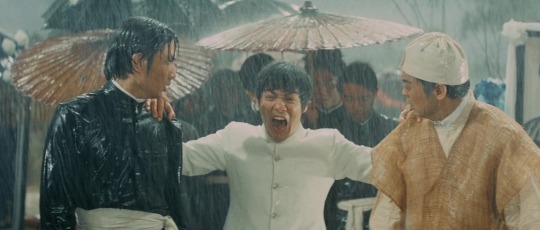

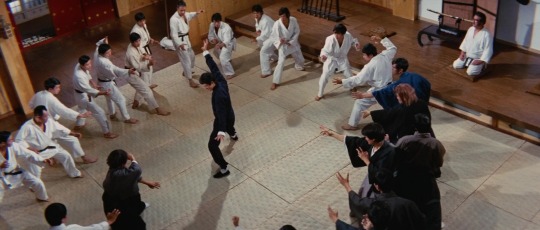
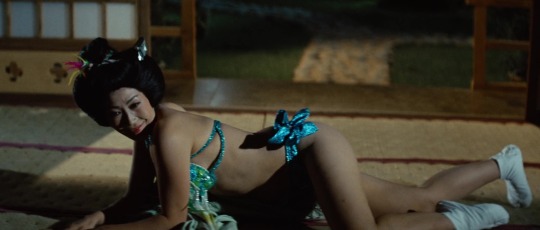

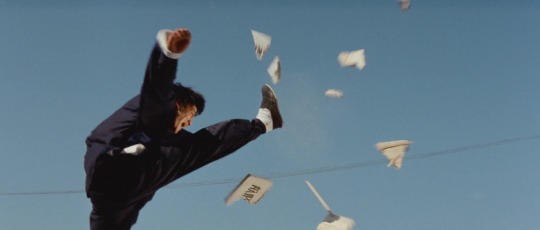


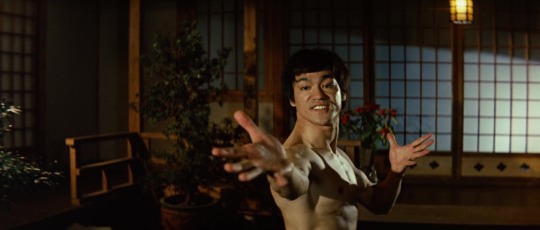
Fist of Fury / Jing wu men (1972, Wei Lo)
Also known as: The Chinese Connection
11/28/21
#Fist of Fury#Bruce Lee#Jing wu men#martial arts#Chinese#Hong Kong#kung fu#70s#Nora Miao#James Tien#Maria Yi#Fu Ching Chen#Tien Feng#action#drama#Japanese Empire#colonialism#Shanghai#revenge#feud#patriotism
52 notes
·
View notes
Photo

The Way of the Dragon 1972
17 notes
·
View notes
Text
Idea currently living rent free in my brain: MDSZ/TGCF/Marvel crossover
Loki hit on Xie Lian one (1) time and now Hua Cheng is just always low key trying to assassinate him.
Thor: Brother, did he just try to push you off the rainbow brdge?
Loki: Crimson Rain tries to kill me every so often. But not, you know, seriously.
Thor: Will I regret asking why?
Loki: I hit on his boyfriend-
Hualian in chorus: -husband-
Loki: -once, so now it’s a thing.
Thor: You attempted to flirt with another man’s husband? That’s very rude.
Loki: It was when we first met, how was I supposed to know they were married?
Wei Wuxian: Dude, they are the most married. And this is me talking.
LWj: Mn.
#marvel#mcu#thor#loki#tian guan ci fu#heaven official's blessing#hua cheng#xie lian#mdsz#the untamed#chen ching ling#wei wuxian#wei ying#lan wangji#lan zhan
26 notes
·
View notes
Photo
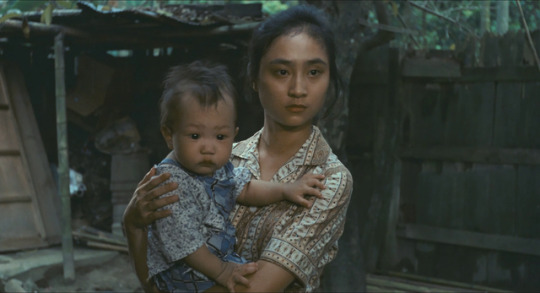
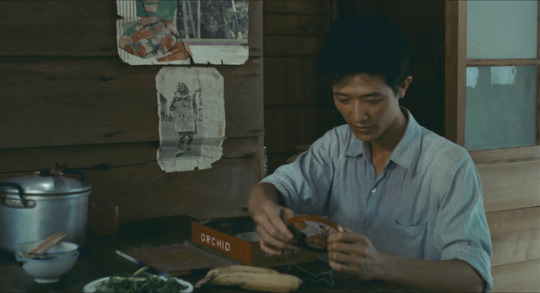





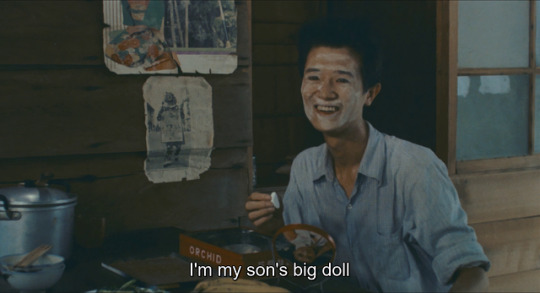
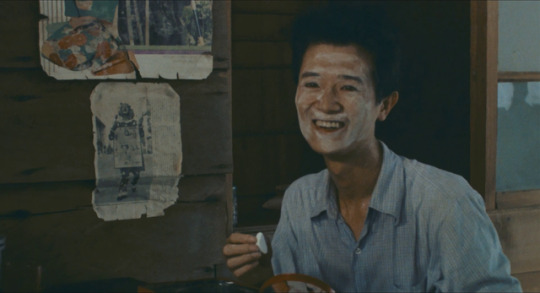

The Sandwich Man (Hou Hsiao-Hsien, 1983).
#the sandwich man#the sandwich man (1983)#hou hsiao-hsien#er zi de da wan ou#Er zi de da wan ou (1983)#hsiao-hsien hou#kun-hou chen#ching-song liao#Fu-Hsiung Lee
29 notes
·
View notes
Photo

Cheng Man Ching è considerato uno dei più grandi maestri di Tai Chi dei tempi moderni. Fu un pioniere nel portare il Tai Chi e la filosofia cinese in Occidente.
Fu unico, non solo un notevole artista marziale ma anche un abile pittore, poeta, studioso e dottore in medicina cinese. Tutti i suoi talenti erano profondamente radicati nelle filosofie del Taoismo e del Confucianesimo, e trovavano armonia nel modo in cui gli umani si relazionano tra loro e con la natura.
Il professor Cheng ha visto il Tai Chi Chuan come un'incarnazione delle leggi naturali e come un percorso di crescita umana - un modo di vivere, un modo per trovare significato, equilibrio e pace.
Attaccato alla tradizionale ma di mentalità aperta, Cheng proveniva da un mondo conservatore. In Cina è stato un pittore, un dottore e un professore di successo. Negli anni '20 ha studiato a Shanghai con il grande maestro del Tai Chi Yang Cheng-Fu che continuava un lignaggio di centinaia di anni.
Dopo anni di studio, il Prof. Cheng ha rivoluzionato la forma. Accorciandola da 108 a 37 posizioni,e ha regalato al mondo un tai chi nella sua essenza, rendendolo più accessibile al mondo moderno.
Nel 1949, dopo la rivoluzione, si trasferì a Taiwan, dove i suoi dipinti furono acquistati dal Museo Nazionale. Divenne membro dell'Assemblea nazionale. Era un membro rispettato dell'élite intellettuale e politica.
Ma nel 1962, a 60 anni, Cheng decise di lasciare la sua posizione privilegiata e trasferirsi con la sua famiglia a New York. La sua missione - insegnare agli occidentali le idee profonde della cultura classica cinese. Vivendo semplicemente a Manhattan ha trascorso gli ultimi dodici anni della sua vita a insegnare qui.
Cheng Man-Ching è arrivato negli Stati Uniti tra gli sconvolgimenti politici e sociali degli anni '60. Ha fondato una scuola di Tai Chi nel cuore della Chinatown di New York, dove molti dei suoi studenti erano un insolito gruppo di giovani americani, artisti, scienziati, hippy, operai, radicali che cercavano un significato in un ambiente competitivo, materialista, violento mondo.
Il suo eclettico gruppo di studenti includeva: Ed Young,noto illustratore; Maggie Newman, leader della danza moderna; Stanley Israel, guardia carceraria e presidente del sindacato; Ken Van Sickle, fotografo; Robert Chuckrow, fisico.
Le lezioni e la personalità di Cheng toccarono a fondo i suoi studenti americani che erano aperti sia alle nuove idee che alle vecchie tradizioni. Lo chiamavano "il professore". Gli studenti a loro volta influenzarono Cheng, che divenne più rilassato, flessibile anche giocoso.
Cheng ha dovuto superare i pregiudizi del vecchio mondo per portare un'antica saggezza nel mondo moderno. C'erano molti nella comunità cinese che erano contrari al fatto che il Prof. Cheng insegnasse agli occidentali i "segreti" cinesi. Fu ostracizzato dalla “scuola” cinese, ma Cheng non fu fermato dall'intolleranza. Stabilì una nuova scuola e insegnò con gioia a tutte le razze e nazionalità, uomini e donne.
Cheng ha ispirato e cambiato la vita dei suoi studenti che a loro volta hanno diffuso il Tai Chi e la filosofia cinese in Occidente dove ha messo radici.
IL PROFESSORE fu un uomo che ha cercato di vivere come un "vero essere umano" e che ha superato le divisioni culturali per portare tradizioni antiche nel mondo moderno, insegnando agli occidentali come cercare un modo di vivere diverso da quello da loro conosciuto.
Facebook Tumblr
#tai chi chuan#tai ji quan#kung fu#arti marziali#cina#cinesi#ynag#cheng man ching#wu#chen#stile#maestro#corsi#alessandro niccolai#istruttore#giacomo zini#pistoia#firenze#prato#montecatini#lucca#sesto fiorentino#rifredi#corso#taichi#yang
13 notes
·
View notes
Text

Figure 1. Jiang Biao’s fan calligraphy, UWM Special Collections (cs 000089).
Graduate Research: Chinese Scroll and Fan Work,
Part 10
For the next two weeks, we will focus on the artistic dichotomy of Zheng (正, normative or orthodox) and Qi (奇, unusual or strange ) between five fin de siècle calligraphic fans in our Zhou Cezong Collection of Chinese scroll and fan work. and the work of calligrapher Fu Shan (1607-1684). Zheng is a conservative style, relying on established styles and techniques. Qi is an idea of originality, requiring artists to break from social and political conventions, and challenging recognized norms. According to art historians Dora Ching and Katharine Burnett, the first half of the seventeenth century witnessed Qi as one the primary markers of Chinese art history, which was represented by Fu Shan and a few others. Fu claimed that he would rather have his calligraphy be awkward, not skillful; ugly, not pleasing; deformed, not slick; spontaneous, not premeditated. However, after 1670, this revolutionary pursuit was held in thrall to the prescribed reiteration of Zheng until the late nineteenth and early twentieth centuries, when Kang Youwei (1858-1927) made an emotional harangue against the latter’s stultifying nature.

(From left to right): Figure 2 (a): Detail from rom Figure 1; Figure 2 (b): Detail from the Stele of Mount Yi; Figure 2 (c): Detail from Fu Shan’s work.
The fan in Figure 1 is a small seal script (first appeared in Qin Dynasty: 221-207 BCE) written by Jiang Biao (1860-1899), the educational commissioner who worked with Chen Sanli (see my previous blog) during Hunan Reform from 1897 to 1898. The format of his characters (Figure 2a) drew inspiration from the Stele of Mount Yi (Figure 2b), which contains a quintessential small seal script created around 219 BCE. Both of them emphasize a balanced, neat, and standardized form, symbolizing the main features of Zheng.
However, in Fu’s view, Zheng style was the degeneration of Chinese calligraphy, and only by deviating from this orthodoxy can one’s works attain vitality and the spirit of nature. One of his ways to achieve this vitality is to exaggerate parts of his composition. In Figure 2c, he first stylized the top half of the character to a wiry linearity; then he exaggerated the bottom half with a fluffy and ostentatious curvature. By these exaggerations, the character produces a strong visual contrast and awkward rawness, exhibiting a feeling of novelty and surprise.

Figure 3. Jin Nong’s Guanyin (Bodhisattva).
From Zhongguo meishu quanji, Huihua bian 11 中国美术全集, 绘画编, 第11卷 [The Collections of Chinese art: Painting Section, volume 11](Shanghai: Shanghai renmin meishu chubanshe, 1988), 29.
Fu’s exaggerated presentation of Qi is also manifested by another iconoclastic artist Jin Nong (1687-1763) in the middle of Qing Dynasty. As a great literati-artist, Jin’s paintings retained a charismatic, somewhat whimsical flavor which derived in part from his amateurish exaggeration. In Figure 3, the head of Guanyin (Bodhisattva) is foreshortened to a restricted rectangular space, while his swirling and gargantuan drapery is expanded and elongated to a scope that strains credulity. The stark contrast of the proportion between his head and body is reminiscent of Fu’s audacious approach in Figure 2c.

Figure 4. Peng Yunzhang's fan calligraphy, UWM Special Collections (cs 000094).
The second fan (Figure 4) is a clerical script by Peng Yunzhang (1792-1862), a high official in late Qing Dynasty. Derived from small seal writing, the structure of clerical style is undulating and flaring. For instance, the horizontal stroke will begin with a rounded head similar to a silkworm cocoon and end with a wavelike flourish resembling the tail of wild goose (see the last horizontal stroke in Figure 5). This style reached its zenith during the Eastern Han Dynasty (25-220 CE); and it marks the conclusion of ancient pictographic script and heralds the beginning of the current system of writing.

Figure 5. Detail from Figure 4.
Figure 4 is a faithful imitation of the Ode of XiXia Pathway, which is a cliff stele designed to commemorate governor Li Xi’s achievement to construct a pathway along the face of a precipitous cliff around 171 CE. Peng’s fan possesses the easygoing poise and smoothness of the original stele. However, the character in Peng’s writing is too elegant and orthodox (Zheng), bordering on banality and rigidity. On the contrary, Xixia’s character is imbued with improvised kinetic variations.
Specifically, in terms of structure, Peng’s layout is properly arranged and equally spaced (Figure 6a), whereas in Xixia (Figure 6b), imbalance is the leitmotif---at first glance, the three parallel strokes on the top right give a vertiginous illusion and structural disharmony; nonetheless, they echo the three tilting horizontal strokes on the left. By following an invisible diagonal line, Xixia pushes a directional force that invites audiences to view the images from an oblique angle. This diagonal perspective does not run out of control; instead, it is perfectly buttressed by two prominent perpendicular strokes and two arch-like components in the character, thereby bringing a kinetic balance to the overall structure.

(From left to right) Figure 6 (a): Detail from Figure 4; Figure 6 (b): Detail from Ode of XiXia Pathway; Figure 6 (c): Detail from Fu Shan’s work.
As an advocate of Qi, Fu viewed imbalance as a barometer of his pursuit of Qi. Xixia’s masterful control between imbalance (diagonal kinesthetics) and balance (perpendicular buttress) might serve as the epiphany for his experimentation. In Figure 6c, the three skewed strokes on the top and the two leftward cocoon-shaped dots on the left are joined to create an imbalanced diagonal. However, the central 口and its two supporting vertical lines act as a counterweight to stabilize that imbalanced balance. In this case, the unusualness of Qi does not transgress the boundaries of accepted conventions; rather, it just brings a precipitous visual contrast to animate the stereotypical practices.

Figure 7. Eugen Kirchner’s November (from the MOMA collection).
The use of imbalanced balance in a diagonal composition can also be seen in Western paintings. In the aquatint November (Figure 7), Eugen Kirchner (1865-1938) adopts a similar arrow-like diagonal to push the silhouettes of people to their furthest depth (a compositional imbalance). The pronounced diagonal perspective amplifies the blusteriness of the weather (an environmental imbalance), and indicates a sense of dreariness and angst (a phycological imbalance) within the throng. However, the erection of the road sign in the middle right not only works as a supporting counterweight to the composition, but also attenuates the stress from the environmental and phycological imbalance. The road sign is unaffected by the wind and the people move freely to almost a same direction. Here, the imbalanced diagonal is balanced by a vertical sign in regards to the compositional, environmental, and phycological perspective.
View more posts from the Zhou Cezong Collection of Chinese scroll and fan work.
– Jingwei Zeng, Special Collections graduate researcher.
#graduate research#Jingwei#Chinese calligraphy#Chinese fans#Chinese history#art history#Fu Shan#Jiang Biao#Jin Nong#Peng Yunzhang#Eugen Kirchner#Zheng style#Qi style#small seal script#clerical script#Ode of XiXia Pathway#Stele of Mount Yi#Zhou Cezong Collection#Tse-Tsung Chow Collection
55 notes
·
View notes
Text
Ep. 01: Cells
The trainees are split up in small groups. These are called "cells". Each cell consists of three trainees. When a cell does not have enough votes, all three trainees in that cell will be eliminated.
However, trainees can change their cells. Those who rank in the TOP9, get to pick their cell first.
In episode 01, each cell consists of a Korean, a Japanese and a Chinese trainee. The first cells were put together based on their "connections" (something they have in common).
NOTE: Not every cell had that much screen time so not all connections will be included. Same goes for the trainees: not all of them were shown a lot so some cells might be based on speculation.
Cell 1: "Role Models"
- Kim Ye Eun
- Kawaguchi Yurina
- Gu Yizhou
Cell 2: "Athleticism"
- Lee Yun Ji
- Murakami Yume
- Liu Shiqi
Cell 3: "Acting Girls"
- Lee Chaeyun
- Ikema Ruan
- Lin Chenhan
Cell 4: "Youngest"
- Guinn Myah
- Kuwahara Ayana
- Liu Yuhan
Cell 5: "Crayon Shin-Chan"
- Kim Chaehyun
- Kanno Miyu
- Huang Xingqiao
Cell 6: "Invertebrate Girls"
- Kang Yeseo
- Kamikura Rei
- Chiayi
Cell 7: "Almost debuted together"
- Lee Yeon Gyung
- Sakamoto Mashiro
- Cui Wenmeixiu
Cell 8: "Game Lovers"
- An Jeongmin
- Shima Moka
- Ma Yuling
Cell 9: "Jin Goo Oppa"
- Choi Yeyoung
- Ito Miyu
- Wen Zhe
Cell 10: "Good dancer"
- Sim Seungeun
- Ando Rinka
- Chien Tzuling
Cell 11: "Main Vocalist"
- Kim Hyerim
- Kubo Reina
- Xia Yan
Cell 12: "Number One Vocalist"
- Jeong Jiyoon
- Nakamura Kyara
- Wang Yale
Cell 13: "All-rounder"
- Kim Suyeon
- Nonaka Shana
- Fu Yaning
Cell 14: "Girls who love chicken feet"
- Huh Jiwon
- Sakurai Miu
- Cai Bing
Cell 15: "Mint chocolate lovers"
- Yoon Jia
- Oki Fuka
- Li Yiman
Cell 16: "I have an album on my own"
- Choi Yujin
- Okazaki Momoko
- Xu Ziyin
Cell 17: "Girls Generation"
- Kim Bora
- Hayase Hana
- Zhang Luofei
Cell 19: "Pretty Girls"
- Kim Doah
- Okuma Sumomo
- Chen Hsinwei
Cell 20: "Top Ones"
- Kim Dayeon
- Ezaki Hikaru
- Shen Xiaoting
Cell 21: "Survival Once Again"
- You Dayeon
- Kishida Ririka
- Su Ruiqi
Cell 22: "26 Years of Experience in Dancing"
- Lee Sunwoo
- Hiyajo Nagomi
- Poon Wingchi
Cell 23: "Talkative ENFP"
- Lee Hyewon
- Kamimoto Kotone
- Liang Jiao
Cell 24: "Crybaby"
- Joung Min
- Hayashi Fuko
- Liang Qiao
Cell 25: "New Trainee"
- Huening Bahiyyih
- Sakamoto Shihona
- Hsu Nientzu
Cell 26: "Girl who gnaws ribs"
- Cho Haeun
- Arai Risako
- Xu Ruowei
Cell 27: "Cat Butler"
- Ryu Sion
- Terasaki Hina
- Chang Ching
Cell 28: "Language Masters"
- Lee Rayeon
- Yamauchi Moana
- Wu Tammy
Cell 29: "03s"
- Han Dana
- Aratake Rinka
- Wang Qiuru
Cell 30: "Ballerinas"
- Seo Youngeun
- Inaba Vivienne
- Ho Szeching
Cell 31: "K-POP self-educated"
- Kim Sein
- Nagai Manami
- Leung Cheukying
Cell 32: "K-Drama fan"
- Kim Yubin
- Kitajima Yuna
- Yang Zige
Cell 33: "Giant Girls"
- Suh Jimin
- May
- Zhou Xinyu
68 notes
·
View notes
Photo


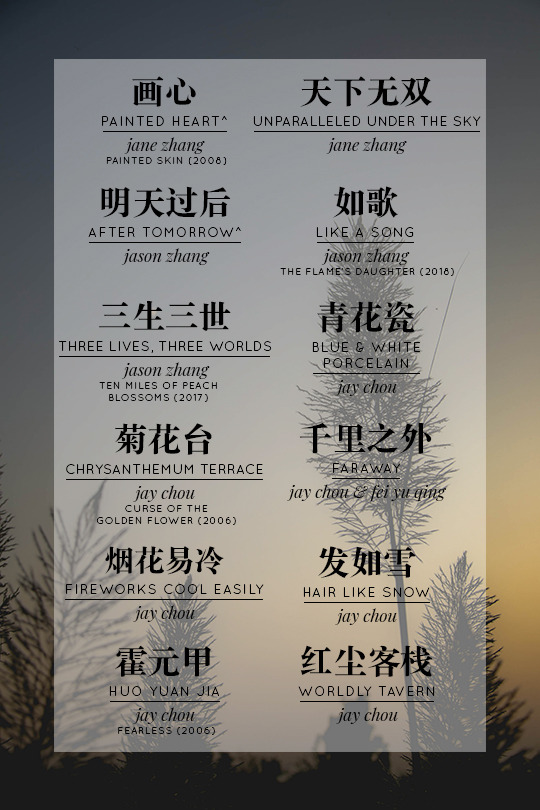
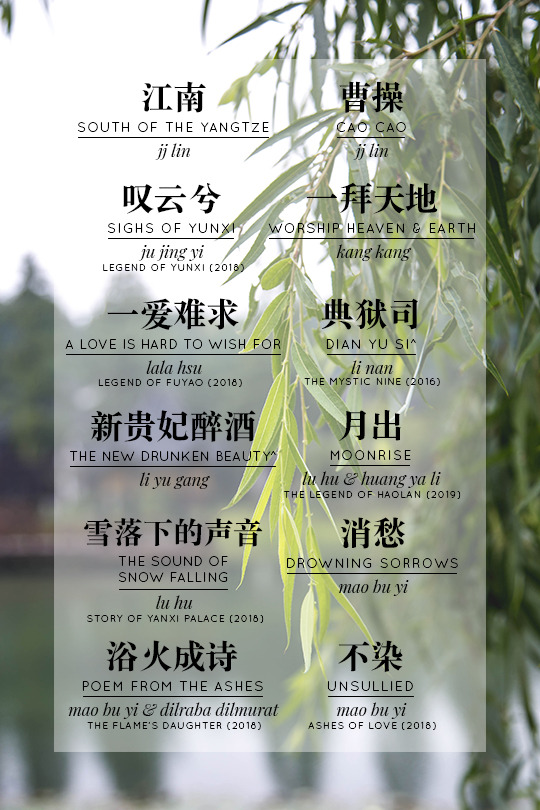



Recently collaborated with the amazing @sansatully (whose own playlist that inspired this collab can be found here!) to put together a playlist of 65 songs - 江风: A Collection of Chinese Songs ♫꒰・◡・๑꒱
[spotify] [youtube (more complete)]
To those who are looking for more songs that sound similar to those in the soundtrack of The Untamed, to those who want a list of Chinese songs to write, draw, work, study, or read to, or to those who are simply looking for new tunes: this one’s for you ✩°。⋆⸜(ू˙꒳˙ )
* not on Spotify
^ on Spotify by a different singer
More information on the playlist and selected songs below!
《赠花卿》 杜甫
锦城丝管日纷纷,半入江风半入云。
此曲只应天上有,人间能得几回闻。
Dedicated to General Hua (Du Fu 712-770)
In Jin City, the melodies of string and wind instruments are heard daily
Half of the music is carried by the wind over the river and half of the music drifts up to the clouds
This music should only belong in heaven
How many times can it be heard in the mortal world?
A large number of these songs are from the 中国风 (zhong guo feng “Chinese style”) genre: songs that are typically characterised by the use of traditional Chinese instruments, a pentatonic scale instead of heptatonic, and lyrics that allude to Chinese culture and/ or imagery. [x] [x]
F.I.R. 飞儿乐团: Thousand Years of Love 千年之恋
A really cool song with elements of rock that will bring you to the western deserts of China
Jackie Chan 成龙: Endless Love 无尽的爱 (from The Myth 神话) with Kim Hee-sun 김희선
Has Korean in it! The Korean lyrics in this particular YouTube video are the Chinese translations of the Korean lyrics; other videos are Chinese gibberish that sound like the Korean lyrics
Jay Chou 周杰伦: Blue and White Porcelain 青花瓷
Warning: very sad MV
The actor who plays the male lead in the MV is Baron Chen, who has also appeared in Fights Break Sphere and Pillow Book
Jay Chou 周杰伦: Faraway 千里之外 with Fei Yu Qing 费玉清
Fei Yu Qing (or Fei Yu Ching) is a 60+ year old Taiwanese singer who looks like he’s in his 30s-40s (ʘᗩʘ’)
Jay Chou 周杰伦: Fireworks Cool Easily 烟花易冷
First part of the MV is REALLY silly but the song is A+ and the lyrics are extremely pretty
To quote a comment: “妈蛋找遍中国的网站都没这首MV,还得翻墙来看,可这是什么鬼😂 damn it (literally mother egg lol) searched the entire Chinese web but couldn’t find the MV for this song, had to cross the firewall to see this, but what the hell is this 😂”
Jay Chou 周杰伦: Huo Yuan Jia 霍元甲 (from Fearless 霍元甲)
Some parts in rap and other parts in Beijing opera style overall A++ combination
Jay Chou 周杰伦: Worldly Tavern 红尘客栈
Another sad MV
The lyrics of this song allude heavily to poet Tao Yuan Ming 陶渊明 (c.365-427AD)
Li Nan 李楠: Dian Yu Si 典狱司 (from The Mystic Nine 老九门)
Some parts in Beijing opera style
Please listen to the Youtube version instead of the Spotify one, it’s much better
Li Yu Gang 李玉刚: The New Drunken Beauty 新贵妃醉酒
Some parts in Beijing opera style
Li Yu Gang is a Beijing opera performer who specialises in the “nan dan” role (i.e. males who play female roles)
PLEASE listen to the Youtube version, because the Spotify version has some weird ass rap for most of the song
Qi Ran 奇然: The Pipa Player 琵琶行 with Shen Mi Ren 沈谧仁
Some parts in Beijing opera style
The lyrics of this song are actually a poem by Bai Ju Yi 白居易 (772-846AD)
Sa Ding Ding 萨顶顶: Upwards to the Moon 左手指月(from Ashes of Love 香蜜沉沉烬如霜)
This song stretches across 3 octaves (◯Δ◯∥)
S.H.E.: Chinese Language 中国话
Challenge: try rapping this song
Wang Leehom 王力宏: Bridge of Fate 缘分一道桥 (from The Great Wall 长城) with Sitar Tan 谭维维
Amazing song with extremely powerful vocals
Wang Leehom and Sitar Tan sing in two different vocal styles: Wang Leehom sings in pop, and Sitar Tan performs a traditional Qinqiang - a folk Chinese opera style from Shaanxi Province
Don’t ask me why Matt Damon is in it ಠ_ರೃ
Zhou Shen 周深: Big Fish 大鱼 (from Big Fish & Begonia 大鱼海棠)
Don’t be deceived, Zhou Shen, the same Zhou Shen who sang Xue Yang’s character song in The Untamed, is a male singer!
#this was super duper fun!!#so many nice songs it was so difficult to choose which to put in asdfghjkl#thank you so much for the collab @sansatully ^^#*recs#!#playlist#chinese playlist#youtube playlist#spotify playlist#music playlist#the untamed#ashes of love#three lives three worlds#scarlet heart#jay chou#jj lin#mao bu yi#yin lin#zhou shen#queena cui#collab#youtube#spotify#chinese music#chinese style music#zhongguofeng#music
593 notes
·
View notes